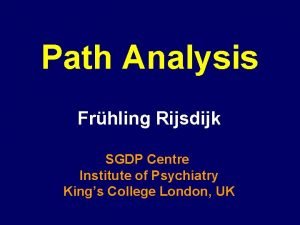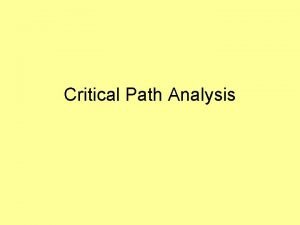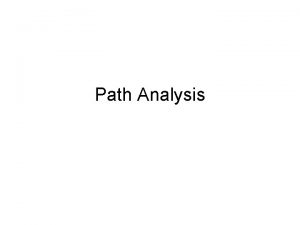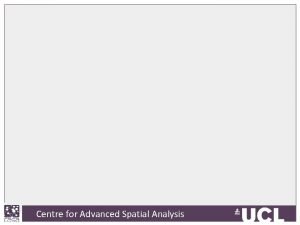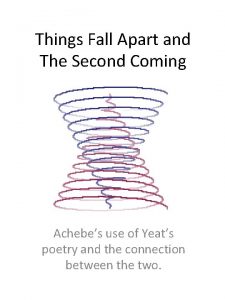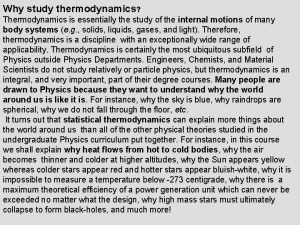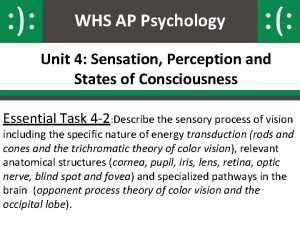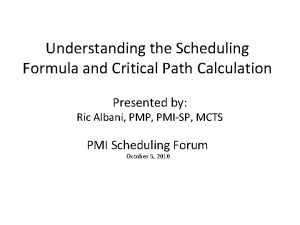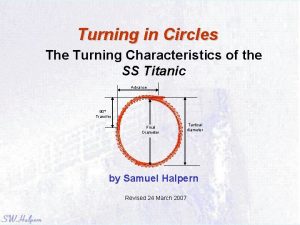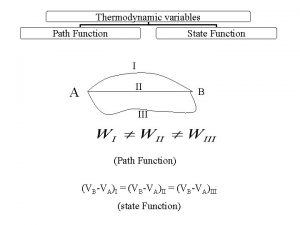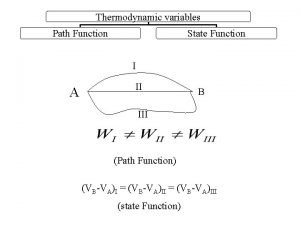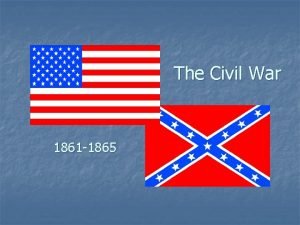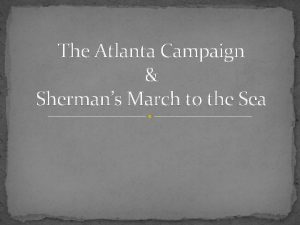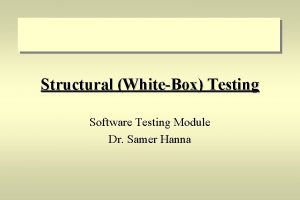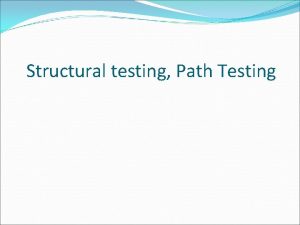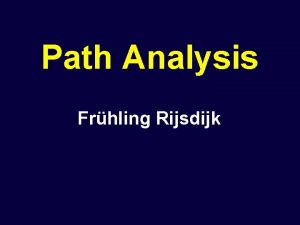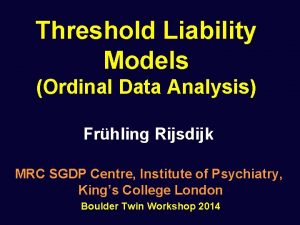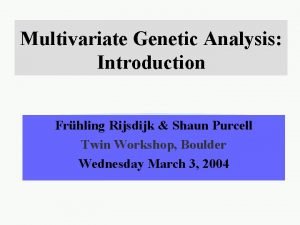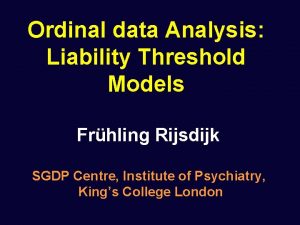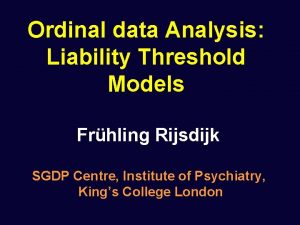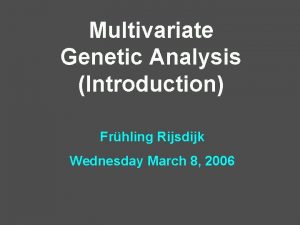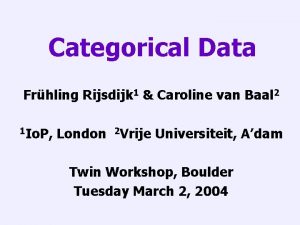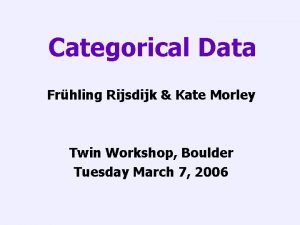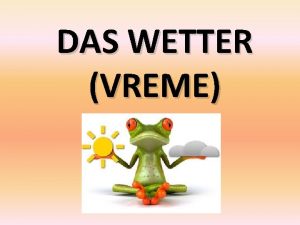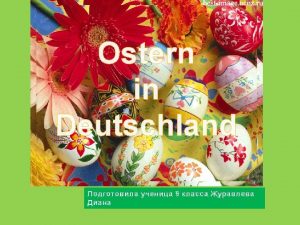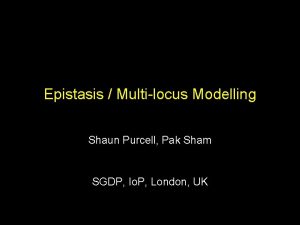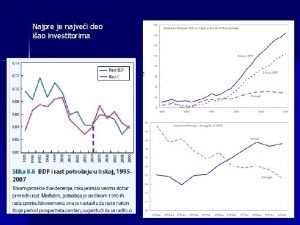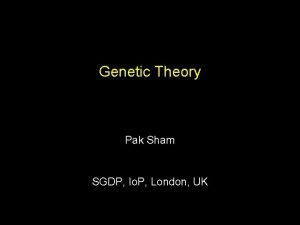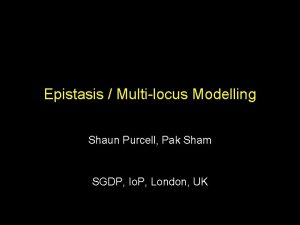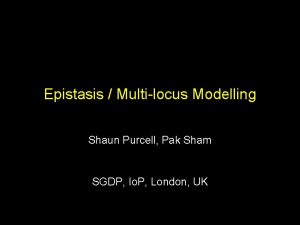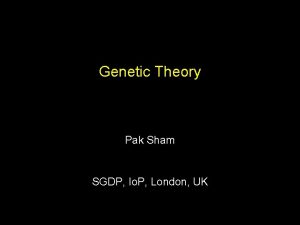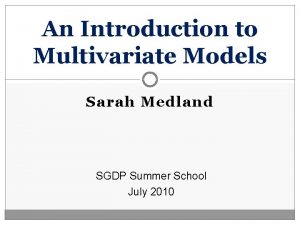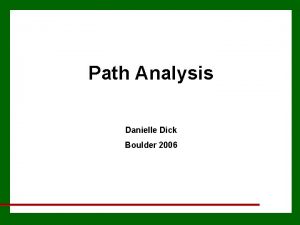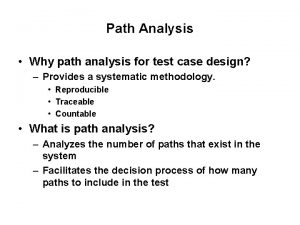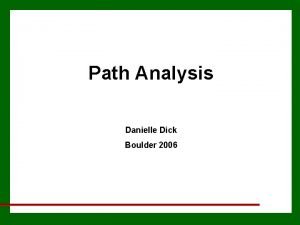Path Analysis Frhling Rijsdijk SGDP Centre Institute of

































- Slides: 33

Path Analysis Frühling Rijsdijk SGDP Centre Institute of Psychiatry King’s College London, UK

Twin Model Twin Data Preparation Assumptions Biometrical Genetic Theory Hypothesised Sources of Variation Model Equations Observed Variation Matrix Algebra Path Diagrams Covariance Algebra Path Tracing Rules Predicted Var/Cov from Model Summary Statistics Observed Var/Cov from Data Structural Equation Modelling (Maximum Likelihood)

Path Analysis Developed by the geneticist Sewall Wright (1920) Now widely applied to problems in genetics and the behavioural sciences.

Path Analysis This technique allows us to present linear relationships between variables in diagrams and to derive predictions for the variances and covariances of the variables under the specified model. The relationships can also be represented as structural equations and covariance matrices All three forms are mathematically complete, it is possible to translate from one to the other. Structural equation modelling (SEM) represents a unified platform for path analytic and variance components models.

In (twin) models, expected relationships between observed variables are expressed by: • A system of linear model equations or • Path diagrams which allow the model to be represented in schematic form Both allow us to derive predictions for the variances and covariances of the variables under the specified model

Aims of this Session Derivation of Predicted Var-Cov matrices of a model using: (1) Path Tracing (2) Covariance Algebra

Path Diagram Conventions Observed Variable Latent Variable Causal Path Covariance Path

Path Diagrams for the Classical Twin Model

1 1 C E 1 1 1 e A c Twin 1 C A a 1 1 1 a E c e Twin 2 Model for an MZ PAIR Note: a, c and e are the same cross twins

1. 5 C E 1 1 1 e A c Twin 1 a C A 1 1 1 a E c e Twin 2 Model for a DZ PAIR Note: a, c and e are also the same cross groups

Path Tracing The covariance between any two variables is the sum of all legitimate chains connecting the variables The numerical value of a chain is the product of all traced path coefficients in it A legitimate chain is a path along arrows that follow 3 rules:

(i) Trace backward, then forward, or simply forward from one variable to another. NEVER forward then backward! Include double-headed arrows from the independent variables to itself. These variances will be 1 for latent variables (ii) Loops are not allowed, i. e. we can not trace twice through the same variable (iii) There is a maximum of one curved arrow per path. So, the double-headed arrow from the independent variable to itself is included, unless the chain includes another double-headed arrow (e. g. a correlation path)

The Variance Since the variance of a variable is the covariance of the variable with itself, the expected variance will be the sum of all paths from the variable to itself, which follow Wright’s rules

Variance of Twin 1 AND Twin 2 (for MZ and DZ pairs) 1 E e C 1 c Twin 1 1 a A

Variance of Twin 1 AND Twin 2 (for MZ and DZ pairs) 1 E e C 1 c Twin 1 1 a A

Variance of Twin 1 AND Twin 2 (for MZ and DZ pairs) 1 E e C 1 c Twin 1 1 a A

Variance of Twin 1 AND Twin 2 (for MZ and DZ pairs) 1 E e C 1 c Twin 1 1 a A a*1*a = a 2 +

Variance of Twin 1 AND Twin 2 (for MZ and DZ pairs) 1 E e C 1 c Twin 1 1 a A a*1*a = a 2 + c*1*c = c 2 + e*1*e = e 2 Total Variance = a 2 + c 2 + e 2

Covariance Twin 1 -2: MZ pairs 1 1 1 C E 1 1 e A c Twin 1 C A a 1 1 1 a E c Twin 2 e

Covariance Twin 1 -2: MZ pairs 1 1 1 C E 1 1 e A c Twin 1 C A a 1 1 1 a E c Twin 2 e

Covariance Twin 1 -2: MZ pairs 1 1 1 C E 1 1 e A c Twin 1 C A a 1 1 1 E a c Twin 2 Total Covariance = a 2 + e

Covariance Twin 1 -2: MZ pairs 1 1 1 C E 1 1 e A c Twin 1 C A a 1 1 1 a E c Twin 2 Total Covariance = a 2 + c 2 e

Predicted Var-Cov Matrices Tw 1 Tw 2

ADE Model 1(MZ) / 0. 25 (DZ) 1/. 5 D E 1 1 1 e A d Twin 1 a D A 1 1 1 a E d Twin 2 e

Predicted Var-Cov Matrices Tw 1 Tw 2

ACE or ADE Cov(mz) = a 2 + c 2 or a 2 + d 2 Cov(dz) = ½ a 2 + c 2 or ½ a 2 + ¼ d 2 VP = a 2 + c 2 + e 2 or a 2 + d 2 + e 2 3 unknown parameters (a, c, e or a, d, e), and only 3 distinct predicted statistics: Cov MZ, Cov DZ, Vp) this model is just identified

Effects of C and D are confounded The twin correlations indicate which of the two components is more likely to be present: Cor(mz) = a 2 + c 2 or a 2 + d 2 Cor(dz) = ½ a 2 + c 2 or ½ a 2 + ¼ d 2 If a 2 =. 40, c 2 =. 20 rmz = 0. 60 rdz = 0. 40 If a 2 =. 40, d 2 =. 20 rmz = 0. 60 rdz = 0. 25 ACE ADE

ADCE: classical twin design + adoption data Cov(mz) = a 2 + d 2 + c 2 Cov(dz) = ½ a 2 + ¼ d 2 + c 2 Cov(adop. Sibs) = c 2 VP = a 2 + d 2 + c 2 + e 2 4 unknown parameters (a, c, d, e), and 4 distinct predicted statistics: Cov MZ, Cov DZ, Cov adop. Sibs, Vp) this model is just identified

Path Tracing Rules are based on Covariance Algebra

Three Fundamental Covariance Algebra Rules Var (X) = Cov(X, X) Cov (a. X, b. Y) = ab Cov(X, Y) Cov (X, Y+Z) = Cov (X, Y) + Cov (X, Z)

Example 1 1 A a Y Y = a. A The variance of a dependent variable (Y) caused by independent variable A, is the squared regression coefficient multiplied by the variance of the independent variable

Example 2. 5 1 A a Y Z Y = a. A Z = a. A

Summary Path Tracing and Covariance Algebra have the same aim : to work out the predicted Variances and Covariances of variables, given a specified model
 Frhling
Frhling Qimata
Qimata Centroid statics
Centroid statics Centroid of wire
Centroid of wire Path analysis in plant breeding
Path analysis in plant breeding Cpa critical path analysis
Cpa critical path analysis Analisis path
Analisis path Path analysis spss
Path analysis spss The difficult path analysis
The difficult path analysis Dr susan o shea
Dr susan o shea Centre for advanced spatial analysis
Centre for advanced spatial analysis Turning and turning in the widening gyre
Turning and turning in the widening gyre International institute for applied system analysis
International institute for applied system analysis Resolving power equation
Resolving power equation Why do we study thermodynamics
Why do we study thermodynamics Path of light through the eye
Path of light through the eye House path goal theory
House path goal theory Path expression in software testing
Path expression in software testing Scheduling formula
Scheduling formula Uc anr portal
Uc anr portal Follow the path shown by innovative entrepreneur
Follow the path shown by innovative entrepreneur Parts of turning circle
Parts of turning circle Titanic path
Titanic path Heat capacity is path function
Heat capacity is path function Pressure is state function or path function
Pressure is state function or path function Shortest path to get food
Shortest path to get food The diagram below shows the path of a comet around the sun
The diagram below shows the path of a comet around the sun Path of sherman's march to the sea
Path of sherman's march to the sea River ganga path
River ganga path Path of sherman's march to the sea
Path of sherman's march to the sea Uhv surface science
Uhv surface science Ispathwarm
Ispathwarm Dd path in software testing
Dd path in software testing Basis path testing
Basis path testing
